Abstract
The conservation project of built heritage is a complex process, dealing with an extremely heterogeneous range of elements and different substrates with a large variety of conservation conditions. In recent years, its sustainability has become a relevant issue, due to the general limitation of resources and unique features of cultural heritage assets. The conservation project, therefore, requires a thorough knowledge of the specific characteristics of the site, a reliable evaluation of the treatment’s efficacy and durability, and efficient control of procedures and timing of the site during the conservation activities. A suitable approach to design the intervention is the implementation of a pilot site for the knowledge of surfaces and structures, and for the testing of different operative procedures. This approach needs the collaborative work of a multidisciplinary team coordinated by the project manager. This paper reports on the design of the conservation project of the Renaissance façade of the Monza cathedral, with the development of a pilot site as a relevant example of a complex surface. The three-phase process—preliminary knowledge, testing and implementation of the treatment methodologies, and scale-up to the general conservation project—is described and discussed with significant reference to real data from the case study.
1. Introduction
The surfaces of architectural heritage are unique and irreplaceable landmarks that contribute to the definition of the identity of cities and communities. In particular, the role of historical architecture as an “expression of the richness and diversity of Europe’s cultural heritage” has been clearly stated by the Council of Europe [1]. Since its early stages, the long-lasting and fertile debate on the conservation of built heritage has emphasized the inherent stratification of historical, aesthetic, and technological values characterizing buildings and sites of cultural significance [2]. All over the world, the preservation of built heritage is actively pursued through conservation strategies for its transmission to future generations and the protection of its authenticity [3,4]. Nevertheless, the conservation project of historical buildings is a complex and expensive process, dealing with a wide range of architectural elements, made of a variety of different materials, with quite a large extension. In recent years, the sustainability of this process has become more and more important due to the general limitation of resources. This requires a reassessment of the intervention and maintenance strategies by the main actors involved in the safeguard, decision-making, management, and planning phases of conservation towards more highly efficient approaches. Following this direction, efforts have been made to apply the well-established tools of sustainability to the environmental, economic, and social aspects of cultural heritage conservation [5].
Under the operational point of view of the heritage conservation, sustainability is a multi-faceted objective that can be addressed following several directions, including the selection of cost-effective restoration materials to meet the specific site’s requirements and constraints [6]; the use of procedures that are respectful of both the environment and the operators; the definition of methodological approaches to reduce the risk of materials and treatments incompatibility [7,8]; the implementation of strategies to grant adequate durability of the conservation solutions, also considering the current global climate change scenario [9,10]; optimized scheduling of the conservation activity, and managing of the financial resources.
Monumental, historical, and modern architecture, as well as the diffused built heritage, face prolonged exposure to outdoor environments that can be extremely challenging for the substrates especially in polluted urban atmospheres. Severe damages affect historical surfaces [11,12], posing a serious risk of losing architectural elements and details that characterize building traditions and skills across the centuries. The sequence of restoration and maintenance activities usually carried out during the lifetime of buildings and sites further increases the complexity. Restoration treatments indeed substantially alter the equilibrium of the materials at work with the objective of improving the overall conservative conditions. The risk of possible incompatibilities with respect to the historic substrates can be minimized, but not completely excluded [7].
The project of conservation should be based on a thorough knowledge of materials and their conditions, achieved through a careful diagnostic examination of the different architectural elements. The diagnostic results allow for the setup of adequate guidelines for the different conservation phases—cleaning, consolidation, gluing, sealing and re-jointing, and protection [13]. Nevertheless, these guidelines alone are not sufficient to implement executive planning for a satisfactory intervention, which should also rely on: the thorough knowledge of the specific features of the site (environmental and microclimatic conditions) [14]; the reliable evaluation of the treatment materials and methodologies on site [15,16,17]; the efficient control during the execution of the conservation activities; the assessment and monitoring of the restoration results, to understand the evolution of the treated surfaces [18,19,20] and to allow the early detection of any incompatibility issue.
To meet these requirements, the project for the conservation of the built heritage should be founded on a solid knowledge basis, which exploits all the possible historical sources and is complemented by a multidisciplinary diagnostic. The decision-making process leading to the definition of the operative steps, the specific methodologies, and the treatment procedures will then follow. The basic operational steps performed during the intervention generally include a preconsolidation of the mechanically weakened substrates to minimize the risk of loss of historic materials during the subsequent operations; cleaning procedures for the removal of all the deposits and reactive materials potentially harmful towards the substrates; re-attachment, integration, and sealing to restore the surface continuity; consolidation treatments to improve the mechanical cohesion; and, finally, surface protection to provide water repellency with the aim of mitigating the overall damaging impact promoted by environmental water. A close collaboration between architects, conservators, and conservation scientists is necessary to meet the conservation goals and, ultimately, to contribute to the overall sustainability of the process.
Good practice in conservation recommends the preliminary testing of the restoration materials and methodologies in the lab and to base any decision on previously acquired experience. This is a cautious and widely recognized strategy, for which extensive data are available in the scientific literature describing the application of many different materials and products for cleaning, consolidation, and protection procedures, tested and assessed through standardized protocols in controlled lab conditions [21,22,23,24,25,26]. At the same time, only a few experiences of onsite testing and long term monitoring of conservation treatments are reported. Even if pilot conservation sites have been implemented to address specific conservation issues, it is still difficult to find comprehensive published results [15,27,28,29,30].
With respect to the traditional approach to the conservation project, the pilot site allows for testing and comparing a wider range of potential solutions in the real exposure conditions on deteriorated surfaces, as well as monitoring the treatments results over a reasonable period of time after the application, thanks to the collaboration between conservation scientists and conservators. The laboratory characterization of reference fresh material also contributes to the overall assessment. The expected outcome is that the most promising procedures can be more precisely identified and further tuned to improve the overall effectiveness and sustainability, optimizing parameters such as application methods, concentration, and times. This, in turn, will allow a highly accurate evaluation of timing and calculation of costs by the executive conservation project team.
This work describes the experience gathered in the context of the project for the preservation of an important Renaissance façade that can be taken as a relevant example of the above-mentioned sustainable approach to the conservation of built heritage.
2. The Case Study: The Façade of the Monza Cathedral
The Monza cathedral (Italy) is a masterpiece of Northern Italy architecture that was re-founded on a pre-existing site at the beginning of the 14th Century and then progressively modified. The construction works of the façade, in particular, started between 1300 and 1345, but a major change in the overall design was necessary after the extension of the interiors. As a result, the façade was enlarged, and its height increased. The current configuration can be attributed to the activity of Matteo da Campione, starting from the second half of the 14th Century [31]. The final design of the façade is based on a five-field scheme (Figure 1a). The central field corresponds to the main aisle and is decorated by a large rose-window, the lateral ones correspond to the side naves, and the external ones to the side chapels. The crowning elements of the façade and the spires belong to a later stage of the construction, as they were concluded only at the beginning of the 20th Century. A wide range of local stones was employed for the cladding and the architectural and decorative elements. Originally, the façade was cladded with alternated rows of Varenna stone slabs (a local black limestone) and white slabs of marble. These materials proved to be not adequately durable, and after a first restoration during the 17th Century, the stone slabs were extensively dismantled and substituted during the early 20th Century restoration. In particular, the black Varenna slabs were completely replaced by Oira stone, a much more resistant metamorphic lithotype (serpentinite), whereas the white ones were cleaned and polished or substituted, depending on their state of conservation. No other complete interventions on the façade have been documented since then, besides the cleaning and some local consolidation of the central portion around 1980 [31].
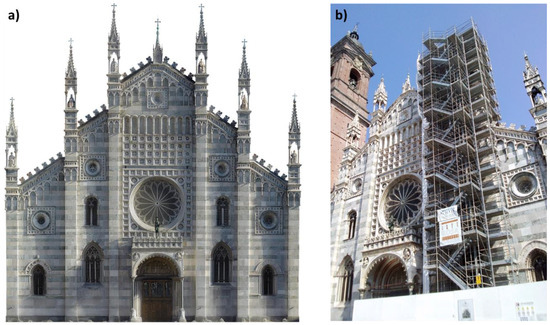
Figure 1.
(a) Orthophoto documentation of the façade of the Monza cathedral; (b) detail of the pilot site area with scaffolding.
After at least a century of outdoor exposure, the state of conservation of the stone surfaces in 2016, at the beginning of the pilot conservation activity, was particularly compromised. Natural environmental factors and anthropogenic pollutants differently affected the stone surfaces according to the exposure conditions and the inherent compositional and microstructural features of the substrates. As a result, the type and magnitude of the decay observed ranged widely from rather mild color alteration of the most durable stones to black crust formation and massive granular disintegration of the highly reactive ones. It has to be considered that the city of Monza is located in the Po Valley, in a densely populated area not far from Milan. From the early 20th Century, the city has almost triplicated its residential populations. In the past, this area was characterized by particularly severe conditions due to the relevant concentrations of solid and gas pollutants. Nowadays, despite an overall improvement of the air quality, the concentrations of particulate matter (especially belonging to the PM10 fraction), NOx, and ozone remain critical [32].
After the preliminary examination of the stone surfaces of the façade, the pilot site area was identified in the mid-left field of the façade (from the ground level to the top of the spire) (Figure 1). This area was indeed highly representative of the most relevant surface features, as for type and state of conservation of the building materials, stone finishings, surface orientations, geometry, and exposure conditions of the different architectural elements (i.e., sheltered, partially or completely exposed to the action of the rain and of the rain runoff). Within the pilot site area were vast portions of the marble and serpentinite slabs of the cladding, a double- and a triple-arched window with remnants of colored patinas, a small rose window framed by a detailed decoration of stone sculpted elements, the crowning elements heavily exposed to precipitations, and one of the main spires hosting the large statue of the queen Teodolinda, partially sheltered from the rain. A seventeen-floor metal scaffolding was installed for the entire duration of the pilot site activity, allowing for stable and close-range access to all the stone surfaces for the diagnostic, testing, and monitoring operations (Figure 1b).
3. General Framework of the Pilot Conservation Site
The pilot site approach is a process of increasing knowledge, which progressively integrates the results from multidisciplinary research contributions to support the definition of the conservation project. The pilot site activity can be divided into three main phases—the condition survey and material characterization, the assessment of the conservation treatments, and the scale-up for the executive project. The core activities of the pilot site are mainly concentrated within the first two phases, while the final one represents the actual link to the design and management of the global intervention. The phases, objectives, and results of the pilot site are summarized in Figure 2.
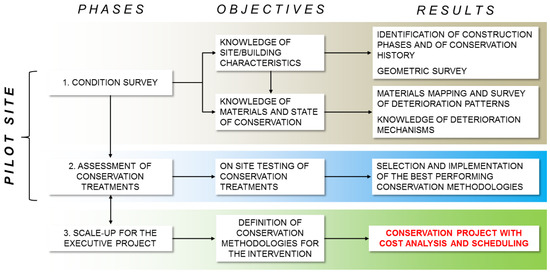
Figure 2.
Scheme of the pilot conservation site phases, objectives, and results.
During the first phase, all the relevant information for a thorough understanding of the site in its own integrity and complexity are gathered and elaborated. These include the historical data of the construction activities and the interventions carried out during the centuries, as well as the spatial and geometrical features of the site. The preliminary knowledge is then completed with the information regarding the materials, the assessment of their state of conservation according to the current guidelines and standard for cultural heritage preservation [33,34,35], and the identification of the deterioration mechanisms.
In the second phase, all the operative actions to ensure the best possible preservation of the materials are set up and implemented. By exploiting the extensive supporting information resulting from phase one, the conservative issues and local critical situations are evidenced. The knowledge of the site geometrical features, materials, and precise state of conservation supports the selection of the most appropriate areas (as for orientation, type of substrate, and main deterioration patterns) to test specific conservation procedures (i.e., cleaning, consolidation, and/or surface protection). Monitoring the medium-term results of the treatments (generally around a 12-month period) is an additional and highly desirable outcome of this phase. It can provide extremely valuable indications about the durability and compatibility of the tested solutions, to be added to the laboratory artificial aging tests.
The last phase is the scale-up of all the operations (the type of materials, different operative parameters, and timing) to define the technical details for the conservation project. As might be expected, adjustments, integrations, and re-thinking of some solutions are necessary during this phase to solve all the additional issues resulting from the change of scale and the related increased complexity. The pilot site approach also limits the risk of over-simplified interpretation of the actual conditions and allows for increasing the flexibility and sustainability of the defined solutions.
4. Phase 1: Condition Survey and Characterization of Materials
Gathering all the historical data from different sources (such as archives, cultural heritage databases, records of previous work retrieved from the professionals involved, etc.) is a necessary and fundamental step to identify the construction/modification phases, as well as the restoration and maintenance activities, that occurred over time [36,37]. All these operations are part of the inherent stratification process of the site, eventually leading to its current configuration, and must be properly recognized as they contribute to the overall historic value. The geometric survey is the operative tool to translate the historical data and the onsite observations into thematic maps, to achieve a thorough knowledge of the materials and their state of conservation. These maps constitute the basis for a coherent conservation project [38].
Considering the remarkable size of the façade (30 m at the base, with a maximum height around 40 m) and the complexity of the architectural and decorative elements, the geometric survey was based on a photogrammetric approach. Figure 1a shows the orthophoto of the façade, from which two cartographic reference maps with drawing scales of 1:50 and 1:20 for the highly detailed areas were derived. The current technical standard [34] and international guidelines [35,39] provide the glossary for the identification of the constituent materials and deterioration patterns after visual examination of architectural elements and surfaces. The location of the different materials in the pilot site was annotated, and the precise identification of the lithotypes was in some cases confirmed by petrographical investigations of stone samples. This evaluation was then extended from the pilot site to the scale of the entire façade, assuming a recurrent scheme of application of lithotypes and exploiting the detailed photographic documentation acquired with the photogrammetric survey. The final result of this activity was a thematic map of the façade in the drawing scale 1:50 (Figure 3, left) showing materials identification and location.
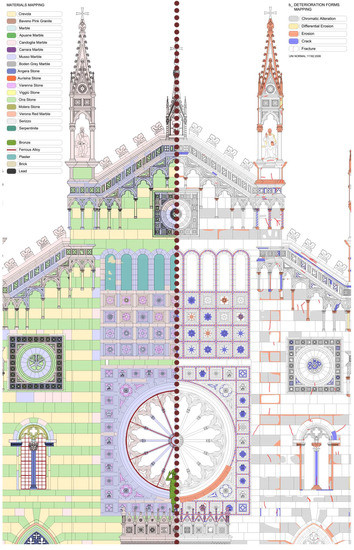
Figure 3.
(Left) materials mapping; (right) deterioration patterns mapping.
This map confirmed the extensive presence of Oira stone for the dark alternated rows of the cladding, whereas the white ones are currently made mainly of Crevola stone, a dolomitic marble. In some areas, however, this stone was substituted either by Musso or by Candoglia, calcitic and medium-to-coarse grained marbles. Candoglia marble is also the main stone employed for the crowning elements and spires that belong to a single and latest construction phase. The greatest variety of lithotypes were observed in the frames and decorations of the double- and triple-arched windows, to create a remarkable decorative pattern by alternating Rosso di Verona (a red-colored limestone), white Apuan marble, Molera stone (a gray sandstone), and Oira stone (Figure 4a). The finely sculpted internal decorations were realized by Viggiù stone (a brown to gray calcitic limestone) and Angera stone (dolostone). The double-arched windows also showed a rather articulated usage of similar stones, with Apuan marble in the frames, Angera stone in the lateral friezes, Aurisina stone in the capital of the central column, and Serizzo, a very durable metamorphic grey stone, in the window sill. The small rose-window and its surrounding decoration were realized alternating white elements of Candoglia and Musso marbles mounted on top of Oira stone slabs (Figure 4b).
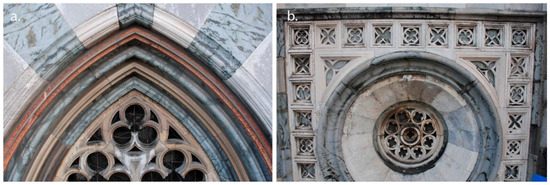
Figure 4.
(a) The articulate decorative usage of various stones in the triple-arch window; (b) decorative tiles in Musso and Candoglia marble and Oira stone.
The main deterioration phenomena affecting the different elements and lithotypes were carefully observed and identified throughout the pilot site, according to the current Italian standard definition [34]. The use of portable diagnostic techniques, such as digital microscopy, allowed for a better understanding of the weathering effects on the different stones and supported the successive laboratory diagnostic phase, minimizing the number of collected samples and analyses. Finally, the observations carried out on the pilot site, together with the highly detailed images acquired during the initial survey, allowed for drawing a complete state of conservation of the façade with sufficient accuracy.
The complexity of the conservative conditions, due to the overlapping of several deterioration patterns onto specific elements or limited areas (Figure 5), required a suitable interpretation of the data to produce a synthetic and effective output. The final graphic representation, therefore, grouped together those deterioration forms, showing a clear relationship with specific lithotypes in separated maps. In this way, four final thematic maps of the deterioration patterns provided an effective description of the overall surface deterioration.
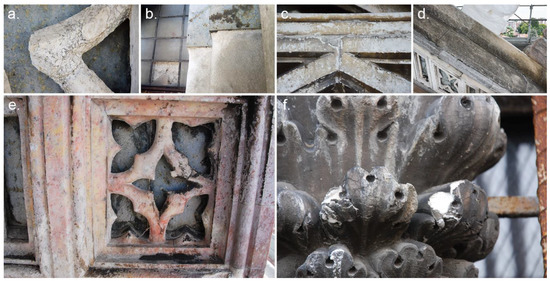
Figure 5.
Conservative conditions of the stone elements of the façade: (a) Granular disintegration and microcracks on a Musso tiles; (b) chromatic alteration and extensive erosion of a Crevola ashlar; (c) oxalate patina and soiling on a Musso decorative element; (d) biological colonization of the crowning elements; (e) chromatic alteration and biological colonization on Candoglia marble; (f) extensive black crust formation, microcracks, and granular disintegration of a marble capital.
In Figure 3, right, is reported an example of the resulting deterioration map. Concerning the state of conservation of Crevola stone, the map shows the remarkable concentration of chromatic alteration phenomena on the surfaces of the slabs. This pattern is clearly associated with the loss of material (confirmed by the surface irregular geometry also observable in the map), due to the extensive erosion clearly visible along the edges. Erosion is also particularly intense in the Crevola columns in the upper part of the façade, which are heavily subjected to the direct rainfall, with both mechanical and chemical action. Evidently, the map shows that the crowning element of the façade and the spires, mostly made of Candoglia marble, are critical areas with respect to these same deterioration patterns.
The precise identification of the main damage mechanisms was achieved by means of a traditional multi-analytical diagnostic approach in the lab. This included optical and scanning electron microscopy, Fourier-transformed infrared spectroscopy, and X-ray diffraction analysis. Specific diagnostic techniques were also employed to analyze the extensive biocolonization affecting the crowning element of the façade, to better understand the potential damaging role of the biofilms [40]. This last phase of the preliminary knowledge of the site features highlighted, as expected, that the deposition of particulate matter and black crust formation were major damage mechanisms of the stone elements partially sheltered from the rain runoff. In particular, intense deposition with a sulfate- and nitrate-rich composition was detected all over the stone frames surrounding the windows, whereas thick and partially fractured black crust covered the windows capitals as well as several areas of the marble decorative elements. The results of the diagnostics conducted on the elements subjected to erosion allowed for assessing the magnitude of the loss of mechanical cohesion of the stone surfaces. All these data were crucial to define an updated scenario of the type and level of risks affecting the different areas and, therefore, to select the most suitable operative conservation actions for the specific issues.
The slabs of the cladding actually represented a particularly critical situation, because of their remarkable extension on the façade and being realized with two stone types with rather different characteristics and durability. A comparative evaluation of the state of conservation of Crevola and Oira stone by means of selected diagnostic results is reported in Figure 6. An intense color alteration affects both stones and represents a primary conservation issue as it has significantly changed the aesthetic appearance of the whole façade. The diagnostic investigation shed light on this peculiar alteration, which is determined by rather different deterioration phenomena, depending on the different mineralogical nature of the two stones.
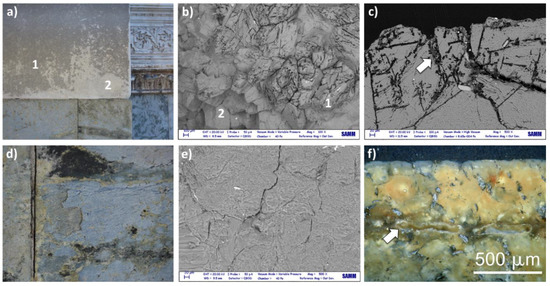
Figure 6.
(a) Conservative conditions of the Crevola cladding; (b) extensive surface decohesion of the stone matrix and fissuring of the grains of Crevola under SEM observation; (c) polished cross-section showing the accumulation of environmental pollutants (arrow); (d) photographic documentation of Oira stone cladding; (e) SEM observation of the surface condition with limited microcracks; (f) polished cross-section showing the detachment of a surface scale (arrow).
The Crevola slabs show intense darkening of the exposed surfaces. Such an effect irregularly affects the stone due to the concurrent loss of material from the outermost portion (Figure 6a), which is determined by the formation of a diffused network of microcracks crossing the single dolomite grains (Figure 6b). The resulting fissures are progressively filled by atmospheric deposits, which contribute to the macroscopic darkening effect observed (Figure 6c). The surface mechanical resistance of the stone is further compromised by the loss of cohesion of the matrix, showing clear and extensive detachments along the grain borders. The dolomitic nature of Crevola marble is particularly sensitive to the action of the rain runoff, causing mechanical and chemical erosion, and also by the cyclic environmental thermal stresses, which can amplify the magnitude of the loss of cohesion between the grains. This is confirmed by the characteristic intensity and distribution of the damage—the deterioration mapping clearly showed an increasing magnitude from the top elements down to the base of the façade, where the cumulative effects of the direct rain and the rain runoff are particularly intense.
The color alteration of the Oira stone consists of the fading of the original dark green hue towards a pale grey-to-blue one, which is associated with a scaling along the slab borders and cracks (Figure 6d). The SEM observation of Oira surfaces (Figure 6e) confirmed the overall good state of conservation of the crystalline matrix of the stone. This is related to the specific geological, petrographic, and compositional features of this silicate-rich serpentinite. Its color alteration results from the selective chemical leaching of the magnesium ions from the phyllosilicate structure, followed by surface recrystallization of low-ordered silicon oxides, due to the interaction with rain and moisture [41]. This process did not significantly affect the mechanical cohesion of the stone, except for the formation of thin scales which eventually detached from the surface (Figure 6f).
5. Phase 2: Assessment of The Conservation Treatments
During this phase, suitable portions of the surface, representative of the most relevant conservation conditions, are selected as playground areas for testing. Each playground is then subdivided into trail areas where different treatment procedures can be performed and compared. The contribution of the restorer is particularly important with respect to the proposal of the materials and conservation methodologies to be tested, the identification of the playgrounds (which should also meet requirements of accessibility of operators and instrumentations), the preparation of the surfaces in view of the conservative treatments, and the appropriate setup of the application methods and related parameters.
According to the extremely compromised state of conservation of the carbonatic stones of the cladding and the sculpted elements of the windows, the activity on the façade was focused on testing the cleaning, consolidation, and protection procedures on these materials. A specific playground was also identified to face the extensive biocolonization of the crowning elements and spires.
The playgrounds for the cleaning included Crevola stone cladding, Angera stone and Candoglia marble capitals, Musso marble and Viggiù stone elements, and Rosso di Verona and Carrara marble frames of the windows. The consolidation and surface protection playgrounds were mainly concentrated on Crevola stone, Candoglia and Musso marble. Eight different cleaning procedures were tested, including water-based methods, controlled micro-sandblasting, chemical poultices, and laser cleaning.
The pilot site approach successfully targeted the cleaning of the colored stones and the surfaces with residual patina and finishing. This was the case, for example, for the capitals of the triple-arched window of the lower level of the façade (Figure 7). Their state of conservation was characterized by a thick and adherent black crust, with an eminently sulfatic composition that completely concealed the marble substrate. Moreover, the preliminary characterization highlighted the presence of a red-colored oxalate-rich patina at the interface between the stone and the crust. Such patina was therefore identified as the target layer for the evaluation of the cleaning efficacy and selectivity. Both laser cleaning and controlled micro-sandblasting were able to effectively remove the sulfatic crust and preserve the target layer. Actually, micro-sandblasting employing rounded and soft inert and laser cleaning with tunable fluency are highly controllable methodologies for the selective removal of very thin surface layers, as they allow a constant evaluation of the cleaning results during the treatment. Moreover, given the limited extension of the surfaces to be treated, both cleaning techniques proved to be sustainable, being time- and cost-effective. The contribution of the diagnostic allowed for defining the best operative condition for the laser cleaning and selecting appropriate working pressures for mechanical cleaning.
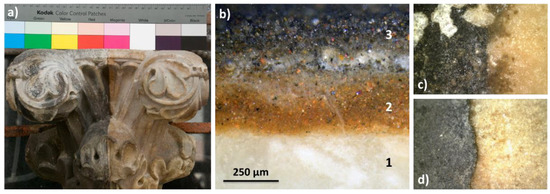
Figure 7.
(a) Trial area for the cleaning of the capitals before (left side of the element) and after cleaning (right side); (b) polished cross-section showing the marble substrate (1) covered by the red oxalate-rich patina (2, target layer of the cleaning) and the sulfatic crust (3); (c) microphotograph of the result of the treatment after laser cleaning and (d) after controlled micro-sandblasting.
As far as the Crevola slabs of the cladding are concerned, the particularly poor conservation conditions of the surfaces that emerged after phase 1 of the pilot site activity suggested the adoption of a mild cleaning technique and the testing of suitable treatments to stabilize and protect the crystalline matrix. Three playgrounds were identified for cleaning, consolidation, and surface protection, between the ground level and around 16 m height.
Ten different trial areas with similar surface conditions were defined to test and compare cleaning procedure, based on nebulized water, different types of micro-sandblasting, and chemical poultices. The evaluation criteria [42] were the efficiency of the cleaning in the removal of deposits, possibility to tune the cleaning action according to different levels of surface cohesion, minimization of the loss of materials from the stone matrix, sustainability in terms of cost, and duration of the operation. This last aspect, in particular, was a relevant issue considering the extent of the surfaces to be treated. The multi-analytical diagnostic evaluation of the playgrounds and the feedback from the restorer who conducted the pilot treatments pointed out that the micro-sandblasting was a suitable methodology to reach acceptable cleaning results (Figure 8). Further investigations were then conducted to optimize the working parameters, in particular, the working pressure, the distance from the surface, and the type of aggregate. Controlled and low-pressure cleaning using rounded dolomitic aggregate was finally implemented.

Figure 8.
Selected results from the playground for the setup of the cleaning of Crevola after digital onsite microscopy and SEM (left to right respectively). (a) Surface before cleaning; (b) surface after cleaning with the implemented methodology showing the removal of the surface deposits and the preservation of the outermost stone grains.
The setup of the consolidation and surface protection treatments followed the definition of the cleaning procedure. The response and efficacy of such treatments indeed depend on the surface conditions, which are significantly modified upon cleaning (and according to the different cleaning methodologies). The pilot application of the treatments was then carried out on 15 trial areas.
The testing of the treatments was carried out in different steps (Figure 9). The first activities were focused on the selection of the materials and the tuning of the application parameters. After a suitable curing period upon application, the control activities based on standard protocols and onsite testing methodologies were conducted to assess and monitor the products performances [13,17]. During the setup phase (Figure 9), two commercial tetraethyl-orthosilicate (TEOS) were identified and tested alone and in association with an ammonium oxalate treatment. The objective was to evaluate the possible contribution provided by the formation of a stable surface layer of calcium oxalate [43] from the combined approach, in comparison with the efficacy of TEOS alone.

Figure 9.
Flow chart summarizing the operative steps for the definition of the consolidation and surface protection methodologies.
A similar approach was used for the setup of the protective systems, which included commercial stone coatings (organosiloxanes, alkylalkoxy-silane, and functionalized SiO2 products) and innovative treatments based on TiO2 nanoparticles [17].
After proper curing time defined according to the specific requirements of the different products, the efficacy of the treatments was investigated by onsite testing of the surface stability and the mechanical cohesion for the consolidants, and the water absorption capability for the protective systems. In particular, a combined investigation of the very superficial stone layers and the more in-depth consolidation effects was achieved by means of peeling tests and micro-drilling (DRMS, Drilling Resistance Measurement System) measurements (Figure 10).

Figure 10.
Phases of the pilot conservation activity for the setup of consolidation and surface protection: (a) treatment’s application; (b) evaluation of the treatment’s results by means of digital microscopy and (c) VIS-spectrophotometric measurements; (d) evaluation of the water absorption behavior and, (e) of the mechanical cohesion by means of DRMS measurements.
Moreover, as the aesthetic compatibility of such treatments is a relevant requirement in cultural heritage, the testing protocol also included the assessment of the surface color change.
The overall sustainability of the consolidation and, in particular, the protective treatments, has to be carefully balanced according to their durability in the actual exposure conditions. This is also an issue that can be more effectively tackled when a pilot conservation site approach supports the traditional laboratory investigation. In the case study, the monitoring period of protective treatments was limited to 12 months, but the final evaluation and selection were based also on the results of the accelerated aging test in the lab.
6. Phase 3: Scale-Up for the Executive Project
The complete corpus of information resulting from the pilot site activity was the working base to scale up the procedures to be adopted in the executive conservation project of the entire façade. The main objectives of this last phase included the precise definition of the final conservation activities, their scheduling, and the cost assessment and check of the overall sustainability of the intervention. The operative tools implemented in this phase were the mapping of the interventions and the related technical working sheets.
The mapping of the interventions was based on the geometric survey and reported the precise locations and extent of the different conservation activity planned for all the areas of the façade. In such a way, and with the support of the information gathered from the deterioration patterns mapping and the results of the pilot site, a series of operations were prescribed to target each specific conditions in terms of the type of substrate and state of conservation. The mapping of the interventions also provided an estimation of the surface areas to be subjected to the different sequences of conservative treatments, which were automatically calculated by CAD software. This evaluation was fundamental for the management of the different phases of the intervention and the assessment of the overall sustainability of the process. On the basis of this information, the economic assessment was performed, and a cost-effectiveness evaluation was carried out to define the allocation of the resources.
The mapping of the intervention was integrated by technical working sheets, which described the operative procedures implemented during phase 2. The technical working sheets were designed to provide practical guidelines for the operators working onsite through step-by-step protocols. They contained highly-detailed information about the materials and equipment to be used, the methodologies and working parameters, and alternative methodologies/procedures to tackle specific conservation issues. This last was a particularly desirable requirement to improve the flexibility and adaptivity of such instruments. The scale-up indeed required a constant check of the actual representativity of the results of the pilot site and the methodologies implemented. In particular, there needed to be proper consideration of the increased level of complexity due to the extended façade surfaces, the possibility that additional and unforeseen conservation issues might arise and, consequently, the need for further procedures and/or for the adjustment of those already defined. This phase therefore also required constant scientific support.
As far as the managing of the global intervention is concerned, there is a strict connection between the technical working sheets and the mapping of the intervention: as the former prescribes the modality of each singular operation, the latter provides the georeferenced location for all of them.
In Figure 11 is reported an example of the mapping of the interventions for the façade, which includes the treatments for the biofilm removal and the consolidation of the stone surfaces.
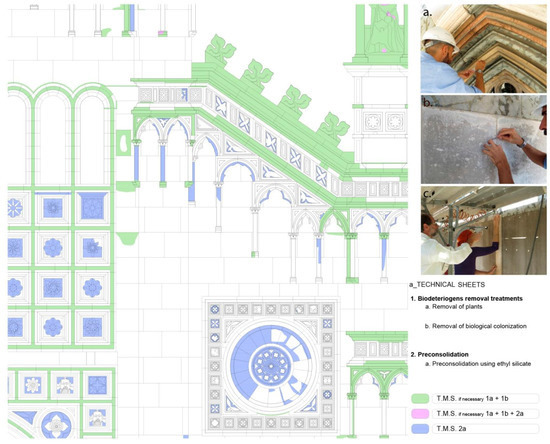
Figure 11.
(Left) Mapping of the interventions for the biofilm removal (green color) and consolidation of the decorative elements (blue color) with references to the related technical working sheet (coded as T.M.S.). (Right) Photographic documentation of the additional testing and checking of the conservative operation conducted (a) on the decorative elements of the triple-arch window; (b) on the Crevola slabs of an ashlar; (c) during cleaning of the cladding.
7. Conclusions
The pilot conservation site is a suitable approach to tackle the inherent complexity of the built heritage preservation. The case study of the Monza cathedral demonstrated that the integrated and multidisciplinary methodology exploited to achieve an accurate understanding of the site allowed for the definition of effective operative procedures and the optimization of the specific parameters of the different conservation treatments.
The state of conservation of the site was assessed by examining and mapping all the representative decay patterns in the pilot areas, according to the different lithotypes. Consequently, the onsite and laboratory diagnostic was effectively directed to investigate the major cause and mechanisms of deterioration. The information gathered during the condition survey phase allowed us to set up the guidelines for the intervention, and select and test the most suitable methodologies for each restoration phase and substrate condition. In particular, the pilot site activity was focused on tuning and optimizing the characteristic parameters of the defined techniques. This, in turn, increased the overall sustainability of the procedures, as scheduling and cost-effectiveness of each phase were optimized.
As a result, the appointed conservation methodologies were effectively scaled up and implemented in the framework of the executive conservation project. Therefore, a much more reliable estimation of the general costs and the duration of the intervention were obtained. The final operative tools of the pilot site activity, namely the mapping of the interventions and the technical working sheets, were directly integrated into the final project, supported the overall planning of the operational activities, and allowed for the assessment of the sustainability in terms of required resources.
Author Contributions
D.G. and L.T. contributed equally to conceptualization, funding acquisition, investigation, methodology, visualization, writing, and review & editing.
Funding
The pilot site activity was supported by “Parrocchia di San Giovanni Battista-Duomo di Monza”.
Acknowledgments
Arch. Margherita Bertoldi is kindly acknowledged for the valuable collaboration during the entire pilot site activity, the support to the on-site diagnostic, for the preparation of the thematic mappings and the scale-up phase.
Conflicts of Interest
The authors declare no conflict of interest.
References
- Council of Europe. Convention for the Protection of the Architectural Heritage of Europe; Council of Europe: Strasbourg, France, 1985. [Google Scholar]
- Dezzi Bardeschi, M. Restauro: Punto e a capo. Frammenti per una (Impossibile) Teoria; Franco Angeli: Milano, Itaily, 2005. [Google Scholar]
- Council of Europe. Amsterdam Charter. European Charter of the Architectural Heritage; Council of Europe: Strasbourg, France, 1975. [Google Scholar]
- ICOMOS. The Nara Document on Authenticity; International Council on Monuments and Sites: Paris, France, 1994. [Google Scholar]
- Settembre Blundo, D.; Ferrari, A.M.; Fernández del Hoyo, A.; Riccardi, M.P.; García Muiña, F.E. Improving sustainable cultural heritage restoration work through life cycle assessment based model. J. Cult. Herit. 2018, 32, 221–231. [Google Scholar] [CrossRef]
- Turk, J.; Mauko Pranjić, A.; Hursthouse, A.; Turner, R.; Hughes, J.J. Decision support criteria and the development of a decision support tool for the selection of conservation materials for the built cultural heritage. J. Cult. Herit. 2018, in press. [Google Scholar] [CrossRef]
- Rodrigues, J.D.; Grossi, A. Indicators and ratings for the compatibility assessment of conservation actions. J. Cult. Herit. 2007, 8, 32–43. [Google Scholar] [CrossRef]
- Revez, M.J.; Delgado Rodrigues, J. Incompatibility risk assessment procedure for the cleaning of built heritage. J. Cult. Herit. 2016, 18, 219–228. [Google Scholar] [CrossRef]
- Sabbioni, C.; Cassar, M.; Brimblecombe, P.; Tidblad, J.; Kozlowski, R.; Drdacky, M.; Sáiz-Jiménez, C.; Grontoft, T.; Wainwright, I.; Ariño, X. Global Climate Change Impact on Built Heritage and Cultural Landscapes; Taylor & Francis Ltd.: Abingdon-on-Thames, UK, 2006. [Google Scholar]
- Nijland, T.G.; Adan, O.C.; van Hees, R.P.; van Etten, B.D. Evaluation of the effects of expected climate change on the durability of building materials with suggestions for adaptation. Heron 2009, 54, 37–48. [Google Scholar]
- Watt, J.; Tidblad, J.; Kucera, V.; Hamilton, R. The Effects of Air Pollution on Cultural Heritage; Springer: Berlin, Germany, 2009. [Google Scholar]
- Siegesmund, S.; Snethlage, R. Stone in Architecture: Properties, Durability, 5th ed.; Springer: Berlin, Germany, 2014. [Google Scholar]
- Doehne, E.F.; Price, C.A. Stone conservation: An Overview of Current Research; The Getty Conservation Institute: Los Angeles, CA, USA, 2011. [Google Scholar]
- Sandrolini, F.; Franzoni, E.; Sassoni, E.; Diotallevi, P.P. The contribution of urban-scale environmental monitoring to materials diagnostics: A study on the cathedral of Modena (Italy). J. Cult. Herit. 2011, 12, 441–450. [Google Scholar] [CrossRef]
- Perez-Monserrat, E.M.; Varas, M.J.; Fort, R.; de Buergo, M.A. Assessment of different methods for cleaning the limestone façades of the former Workers Hospital of Madrid, Spain. Stud. Conserv. 2011, 56, 298–313. [Google Scholar] [CrossRef]
- Delgado Rodrigues, J.; Ferreira Pinto, A.P. Laboratory and onsite study of barium hydroxide as a consolidant for high porosity limestones. J. Cult. Herit. 2016, 19, 467–476. [Google Scholar] [CrossRef]
- Gherardi, F.; Gulotta, D.; Goidanich, S.; Colombo, A.; Toniolo, L. On-site monitoring of the performance of innovative treatments for marble conservation in architectural heritage. Herit. Sci. 2017, 5, 4. [Google Scholar] [CrossRef]
- Salimbeni, R.; Pini, R.; Siano, S.; Calcagno, G. Assessment of the state of conservation of stone artworks after laser cleaning: Comparison with conventional cleaning results on a two-decade follow up. J. Cult. Herit. 2000, 1, 385–391. [Google Scholar] [CrossRef]
- Demoulin, T.; Girardet, F.; Wangler, T.P.; Scherer, G.W.; Flatt, R.J. On-site monitoring for better selection of stone repairs: A case study. Herit. Sci. 2016, 4, 38. [Google Scholar] [CrossRef]
- Papayianni, I.; Stefanidou, M.; Pachta, V. Survey of repaired and artificial stones of the archaeological site of Pella five years after application. In Built Heritage: Monitoring Conservation Management; Toniolo, L., Boriani, M., Guidi, G., Eds.; Springer International Publishing: Berlin, Germany, 2015; pp. 431–442. [Google Scholar]
- La Russa, M.F.; Macchia, A.; Ruffolo, S.A.; De Leo, F.; Barberio, M.; Barone, P.; Crisci, G.M.; Urzì, C. Testing the antibacterial activity of doped TiO2 for preventing biodeterioration of cultural heritage building materials. Int. Biodeterior. Biodegrad. 2014, 96, 87–96. [Google Scholar] [CrossRef]
- Delegou, E.T.; Ntoutsi, I.; Kiranoudis, C.T.; Sayas, J.; Moropoulou, A. Advanced and novel methodology for scientific support on decision-making for stone cleaning. In Advanced Materials for the Conservation of Stone; Hosseini, M., Karapanagiotis, I., Eds.; Springer International Publishing: Cham, Switzerland, 2018; pp. 299–324. [Google Scholar]
- Gherardi, F.; Goidanich, S.; Toniolo, L. Improvements in marble protection by means of innovative photocatalytic nanocomposites. Prog. Org. Coat. 2018, 121, 13–22. [Google Scholar] [CrossRef]
- Raneri, S.; Barone, G.; Mazzoleni, P.; Alfieri, I.; Bergamonti, L.; De Kock, T.; Cnudde, V.; Lottici, P.P.; Lorenzi, A.; Predieri, G.; et al. Efficiency assessment of hybrid coatings for natural building stones: Advanced and multi-scale laboratory investigation. Constr. Build. Mater. 2018, 180, 412–424. [Google Scholar] [CrossRef]
- Roveri, M.; Gherardi, F.; Brambilla, L.; Castiglioni, C.; Toniolo, L. Stone/coating interaction and durability of Si-based photocatalytic nanocomposites applied to porous lithotypes. Materials 2018, 11, 2289. [Google Scholar] [CrossRef] [PubMed]
- Ban, M.; Mascha, E.; Weber, J.; Rohatsch, A.; Delgado Rodrigues, J. Efficiency and compatibility of selected alkoxysilanes on porous carbonate and silicate stones. Materials 2019, 12, 156. [Google Scholar] [CrossRef] [PubMed]
- Moropoulou, A.; Delegou, E.T.; Avdelidis, N.P.; Koui, M. Assessment of cleaning conservation interventions on architectural surfaces using an integrated methodology. MRS Proc. 2002, 712, II2.5. [Google Scholar] [CrossRef]
- Charola, A.E.; Centeno, S.A.; Normandin, K. The New York Public Library: Protective treatment for sugaring marble. J. Archit. Conserv. 2010, 16, 29–44. [Google Scholar] [CrossRef]
- Sassoni, E.; Graziani, G.; Franzoni, E. Repair of sugaring marble by ammonium phosphate: Comparison with ethyl silicate and ammonium oxalate and pilot application to historic artifact. Mater. Des. 2015, 88, 1145–1157. [Google Scholar] [CrossRef]
- Dreyfuss, T. Interactions on site between powdering porous limestone, natural salt mixtures and applied ammonium oxalate. Herit. Sci. 2019, 7, 5. [Google Scholar] [CrossRef]
- Cassanelli, R. Monza anno 1300. La Basilica di S. Giovanni Battista e la sua Facciata; Comune di Monza: Monza, Italy, 1988. [Google Scholar]
- ARPA-Lombardia. Available online: www.arpalombardia.it/sites/QAria (accessed on 1 February 2019).
- ICOMOS. Principle for the Analysis, Conservation and Structural Restoration of Architectural Heritage; International Council on Monuments and Sites: Paris, France, 2003. [Google Scholar]
- UNI 11182:2006. Cultural heritage. Natural and artificial stone. Description of the alteration. Terminology and definition. Ente Italiano di Normazione, 2006. Available online: https://infostore.saiglobal.com/en-au/Standards/UNI-11182-2006-1071699_SAIG_UNI_UNI_2497752/ (accessed on 1 February 2019).
- EN 16096:2012. Conservation of Cultural Property—Condition Survey and Report of Built Cultural Heritage. European Committee for Standardization, 2012. Available online: https://infostore.saiglobal.com/preview/is/en/2012/i.s.en16096-2012.pdf?sku=1566979 (accessed on 1 February 2019).
- ICOMOS. Principles for the Recording of Monuments, Groups of Buildings and Sites; International Council on Monuments and Sites: Paris, France, 1996. [Google Scholar]
- Letellier, R. Recording, Documentation and Information Management for the Conservation of Heritage Places. Guiding Principles; The Getty Conservation Institute: Los Angeles, CA, USA, 2011; Volume 1. [Google Scholar]
- Campanella, C. II Rilievo Degli Edifici: Metodologie e Tecniche per il Progetto di Intervento; Flaccovio: Palermo, Italy, 2017. [Google Scholar]
- ICOMOS. Illustrated Glossary on Stone Deterioration Patterns; International Council on Monuments and Sites: Paris, France, 2008. [Google Scholar]
- Gulotta, D.; Villa, F.; Cappitelli, F.; Toniolo, L. Biofilm colonization of metamorphic lithotypes of a renaissance cathedral exposed to urban atmosphere. Sci. Total Environ. 2018, 639, 1480–1490. [Google Scholar] [CrossRef] [PubMed]
- Gulotta, D.; Bontempi, E.; Bugini, R.; Goidanich, S.; Toniolo, L. The deterioration of metamorphic serpentinites used in historical architecture under atmospheric conditions. Q. J. Eng. Geol. Hydrogeol. 2017, 50, 402–411. [Google Scholar] [CrossRef]
- Toniolo, L. New trends and related problems in stone cleaning and conservation. In New Trends in Analytical, Environmental and Cultural Heritage Chemistry; Colombini, M.P., Tassi, L., Eds.; Transworld Research Network: Kerala, India, 2008; pp. 256–276. [Google Scholar]
- Doherty, B.; Pamplona, M.; Selvaggi, R.; Miliani, C.; Matteini, M.; Sgamellotti, A.; Brunetti, B. Efficiency and resistance of the artificial oxalate protection treatment on marble against chemical weathering. Appl. Surf. Sci. 2007, 253, 4477–4484. [Google Scholar] [CrossRef]
© 2019 by the authors. Licensee MDPI, Basel, Switzerland. This article is an open access article distributed under the terms and conditions of the Creative Commons Attribution (CC BY) license (http://creativecommons.org/licenses/by/4.0/).